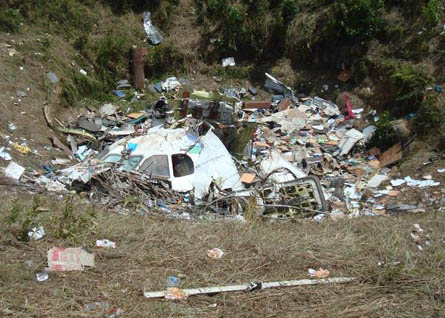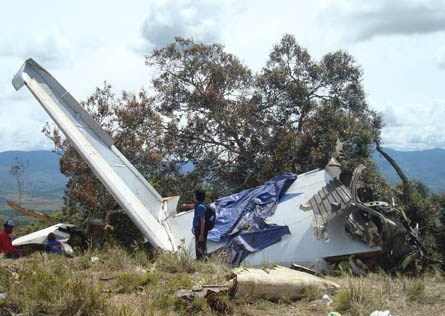Indonesian investigators have detailed the poor airmanship and lack of training which led a British Aerospace 146-300 combi freighter to strike a mountain while attempting a go-around at Wamena, killing all six crew members.
The Aviastar aircraft was conducting a right-hand circuit, at about 150-350ft above the airport elevation, after aborting an approach to runway 15.
But despite the surrounding high terrain, the cockpit-voice recorder showed that the crew failed to respond to nine aural alerts from the enhanced ground-proximity warning system (EGPWS) during the downwind leg, and another nine on the base leg.
The aircraft initially banked into the base turn at 30° but as individuals in the cockpit voiced apprehension about the presence of nearby peaks the captain increased the bank to 41°.
"During the base leg turn, the co-pilot became increasingly concerned about the way the [captain] was handling the aircraft," says the National Transportation Safety Committee. "The concerns were made with increasing levels of anxiety."
The captain rolled the aircraft to the left and its nose began to drop. As the EGPWS signalled warnings about the aircraft's height, bank angle and sink rate, the bank angle increased to 49°.
Flight-data recorder information shows that the aircraft's landing-gear began to retract but was only part-way through the cycle when the 146 hit Pikei Hill on Tengah Mountain, about 3.5nm northwest of the airport.
 |
|---|
 |
|---|
© NTSC |
The NTSC says that the captain's "disregard" for the EGPWS warnings was "in non-conformance" with the instructions in the company operation manual.
"Had the [captain] executed the appropriate responses to those EGPWS alerts it is unlikely that the impact with the terrain would have occurred," it adds.
Neither pilot had received sufficient EGPWS training. The enhanced 'look ahead' function on the EGPWS, adds the NTSC, appears to have been inhibited at the time of the accident on 9 April last year.
"Had the flight crew carefully planned the second approach, and closely co-operated with each other, they may have achieved a safe approach and landing," it states. "The flight crew's disregard of the published procedures bypassed the safety criteria and in-built risk treatments in the design of those procedures."
Source: Air Transport Intelligence news



















